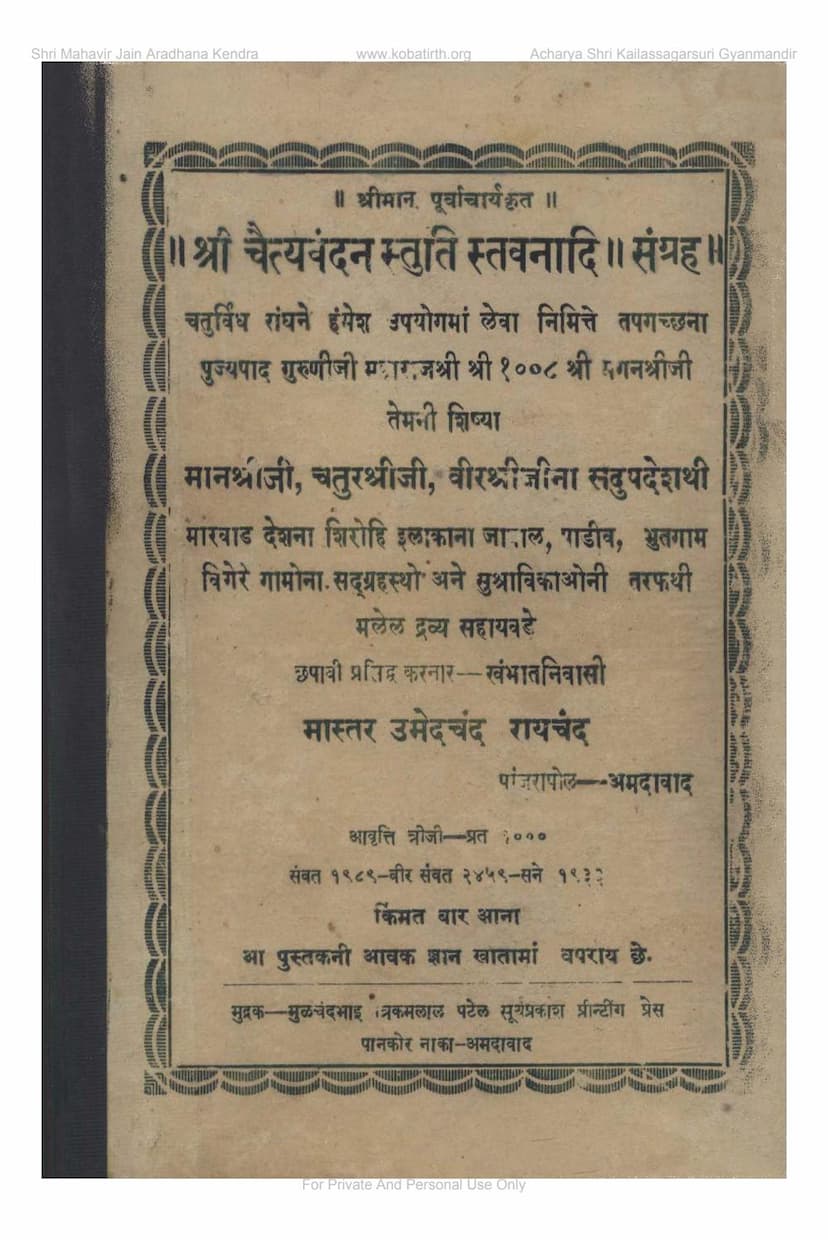Chaityavandan Stuti Stavanadi Sangraha Part 01
Added to library: September 1, 2025

Summary
This document is the first part of a collection of Jain devotional texts titled "Chaityavandan Stuti Stavanadi Sangraha Part 01," compiled by Purvacharya and published by Master Umedchand Raichand. The catalog link is provided as jainqq.org/explore/020137/1. It is intended for private and personal use only.
Key aspects highlighted in the initial pages include:
- Purpose: The book is designed to be a constant resource for the "Chaturvidh Sangh" (the four divisions of the Jain community: monks, nuns, male and female laity).
- Inspiration and Support: The publication was inspired by the guidance of Pujya Guruniji Maharajshri Shri 1008 Shri Maganshriji of the Tapagachha, and her disciples, Manshriji, Chaturshriji, and Virshriji. It was printed with financial assistance from householders and devout female followers from villages in the Marwar region, such as Javal, Padiv, Bhutgam, and others in the Sirohi area.
- Publisher: Master Umedchand Raichand from Khambhat, who has a connection with Panjrapole in Ahmedabad, is credited as the publisher.
- Edition and Publication Details: This is the third edition, with 1000 copies printed in Samvat 1989 (Vir Samvat 2459), corresponding to the year 1912 CE. The price was twelve annas, and the proceeds are to be used for the "Gyan Khata" (knowledge account).
- Printer: Mulchandbhai Trikamlal Patel of Suryaprakash Printing Press, Pankor Naka, Ahmedabad.
- Content: The introduction (Prastavana) explains that the book contains essential Chaityavandans, Stavan, and Stutis compiled by ancient Acharyas. It is printed in Gujarati script, which is considered more beneficial for the readers in the Marwar region than Shastri script. The collection includes previously published works by these Sadhvi Maharajas that are no longer available, along with new useful additions. A separate volume of "Sajjhaymalanu" is planned.
- Gratitude: Appreciation is extended to all individuals who provided financial assistance for the printing.
- Disclaimer: The publishers acknowledge that despite careful attention to accuracy, any errors or omissions are unintentional and would be rectified with "Michhami Dukkadam" (a Jain apology). The reader is directed to the index (Anukramanika) to understand the book's content.
- Biographical Information:
- Shrimati Manshriji Maharaj: A disciple of Shri Maganshriji Maharaj, born in Samvat 1916, and took initiation in Samvat 1939 on Kartik Sud 11 and Ashad Sud 3.
- Param Pujya Guruniji Maharajshri Maganshriji: She was highly influential and originally from Javal village in Marwar. She became a widow at a young age, renounced worldly life after hearing the teachings of Panyas Ratanvijayji, and took Diksha at the age of 30. She was instrumental in spreading Jainism in Marwar and surrounding regions. She had around 40-50 disciples, including Manshriji, Rupashriji, Premsriji, Chaturshriji, and Virshriji. She suffered from an eye ailment for 10-15 years and resided in Javal. Her teachings greatly influenced the people of Marwar.
- Shrimati Manshriji Maharaj (again): She is identified as a resident of Punana, residing in the Jhaate Visa Porwad community. She took Diksha at the age of 23 in Samvat 1916 on Kartik Sud 11 and Samvat 1939 on Ashad Sud 3. She is currently managing and guiding the spiritual activities of the Sangh established by Maganshriji Maharaj. A photograph of her is included in the book, as per the wishes of the householders.
Content of the Index (Anukramanika) on Page 7 onwards:
The index details a vast collection of "Chaityavandans" (devotional salutations to Jain temples/idols) and other devotional pieces. These include:
- Chaityavandans (approx. pages 15-33): Dedicated to various Tirthankaras (Rishabhdev, Ajitnath, Sambhavnath, Adinath, Neminath, Parshvanath, Mahavir Swami, etc.), sacred places like Siddhachala (Shatrunjaya), and concepts like the Pancha Parameshthi, Siddha Chakra, Paryushana, Maun Ekadashi, Ashtami, Navpad, etc. There are also general Chaityavandans.
- Stutins (Prayers/Praises): The index lists numerous stutins dedicated to various Tirthankaras, divine beings, and concepts, covering a wide range of occasions and aspects of Jain practice. This section appears to be extensive, with entries for each Tirthankara and numerous specific devotional pieces related to festivals, vows, and key Jain principles.
- Stavans (Hymns/Songs of Praise): Similar to stutins, this section contains many hymns dedicated to various Tirthankaras, festivals like Paryushana, Diwalī, and specific practices like Rohoṇī Tap.
- Navpad Mahima Varnan (Description of the Glory of Navpad): Several sections are dedicated to praising the nine auspicious elements of Jainism.
- Specific Tirthankara Stutins: The index meticulously lists stutins for each of the 24 Tirthankaras, detailing their auspicious marks (lanchhans) and associated lore.
- Tirth-Specific Stutins: Stutins related to pilgrimage sites like Siddhachala, Girnar, Shatrunjaya, etc. are included.
- Stavans related to Vows and Fasting: Numerous stavans are dedicated to specific Jain vows and fasting practices like Ambila, Upavasa, etc.
- Philosophical and Doctrinal Stavans: Stavans related to concepts like knowledge, perception, conduct (Gyan-Darshan-Charitra), and the stages of spiritual progress (Gun Sthanak) are present.
- Devotional Songs/Laments (Lavanis): The collection includes several "Lavanis," which are devotional songs often sung in a narrative style.
- Various Forms of Devotion: The index indicates a diverse range of devotional practices covered, including prayers, hymns, praises, laments, and descriptions of auspicious events.
Overall Summary:
"Chaityavandan Stuti Stavanadi Sangraha Part 01" is a comprehensive collection of devotional literature for the Jain community, emphasizing traditional practices and the veneration of Tirthankaras and sacred places. It highlights the efforts of esteemed Acharyas and the support of the laity in preserving and disseminating these important spiritual texts. The book serves as a guide for daily prayers, festivals, and vows, aiming to foster spiritual growth and devotion among its readers. The preface also provides valuable biographical context about the influential Acharyas who inspired its creation.